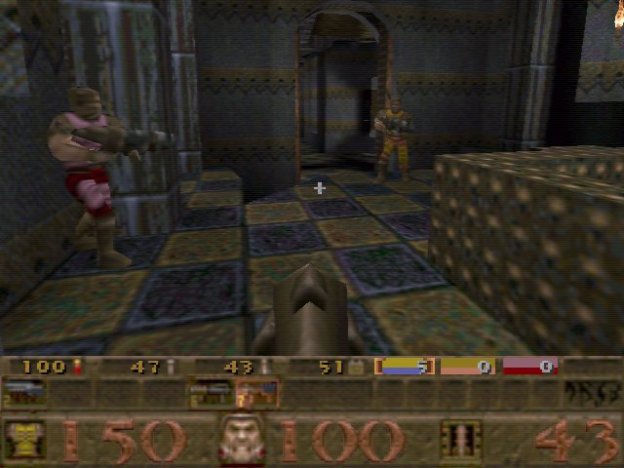
Fifteen years ago, Quake blew us all away. It was a process that started for many of us in the early ’90s withWolfenstein 3D. Here was a game that unfolded entirely through the eyes of its protagonist, a simple experience in which you ran through an elaborate network of corridors, collected weapons and, most importantly, gunned down Nazis.
Doom came next, taking the first-person trappings of Wolfenstein and adding a Hell-comes-to-sci-fi twist. Both of these games were the work of a young, upstart company, id Software, under the guidance of founders John Carmack, John Romero, Tom Hall and Adrian Carmack. They took the lessons learned from those inaugural FPS experiences and applied them to Quake, adding a key element that would help shape the future of interactive entertainment as we now know it.
Quake is counted among the first shooters to add a Y-axis to the aiming controls, allowing players to direct their fire up and down as well as side to side. The real achievement though was bringing this style of gaming into an online space. Suddenly, you were looking through a virtual avatar’s eyes out into an environment filled with other avatars controlled by actual humans. And everyone had guns.
The collective gaming hivemind, still small and scattered at the time, reacted immediately. Here was an opportunity to play out the fantasy of being a Wild West gunslinger and put your fastest draw against another living human. Only there were rocket launchers too. Exaggerated physics and a varied selection of weapons filled out self-contained arenas of death, where explosions tossed all around and gun-toting soldiers bunny-hopped everywhere, firing away the whole time. It was a rhythmic sort of chaos, just as hilarious as it was energizing to watch unfold. Of course it became a hit.
Bethesda Softworks, fellow subsidiary to id owner ZeniMax Media, celebrates the anniversary today with blog post, featuring a message from John Carmack. You can also head over to the source link to check out a vintage interview with him at the inaugural QuakeWorld in 1996.
“I could write an awful lot about Quake, but since we are in the final crunch for Rage right now, I’ll have to settle for just a few random thoughts.
I have a bit more subdued memory of Quake than many of our other projects, because the development was so tough. It was the first project where I really had to grapple with my personal limitations; I had bitten off a little more than I could chew with all the big steps at once – full 3D world, 3D characters, light maps, PVS calculations, game scripting, client / server networking, etc. No matter how hard I worked, things just weren’t getting done when we wanted them to.
My defining memory of the game was fairly early in development, when I no-clipped up into a ceiling corner and looked down as a Shambler walked through the world with its feet firmly planted on the ground. This looked like nothing I had ever seen before; it really did seem like I had a window into another world. Of course, as soon as he had to turn, the feet started to slide around because we didn’t have pivot points and individual joint modifications back then, but it was still pretty magical.
It seems silly now, but at the time we were very concerned that people wouldn’t be able to deal with free look mouse control, and we had lots of options to restrict pitch changes and auto-center when you started moving.
The internet gaming aspect was almost an accident. I had moved from Doom’s peer-to-peer networking to client/server primarily to allow late game entry, and UDP was supported because I was still doing a lot of the development on NEXTSEP unix workstations. The idea of playing over the internet was always there, but I didn’t think it would be practical for many people due to the long latencies and variable performance of typical connections. When it turned out that people were doing it despite the low quality, it gave me the incentive to develop the alternative QuakeWorld executable with the various latency reduction mechanisms.
The other important alternative executable was glQuake, which played a significant role in the early days of 3D accelerators. 3DFX was the gold standard back then – Nvidia’s RIVA128 had poor subpixel precision and didn’t handle all the blend modes properly. In fact, almost everyone was under the incorrect assumption that blending was only good for alpha transparency, even companies like 3DLabs that should have known better.
Competitive deathmatch had gotten started with Doom, but the Red Annihilation Quake tournament was a high point, where I gave my first turbo Ferrari away to Thresh for his dominating tournament win.
I look back at Quake as the golden age of game modding, before the standards rose so high that it required almost a full time commitment to do something relevant. I am very proud that many of today’s industry greats trace their start back to working with Quake.
The most important thing about Quake for me was that I met my wife when she organized the first all-female Quake tournament. She still thinks Quake was the seminal achievement of Id, and she glowers at me whenever I bemoan how random the design was.”


